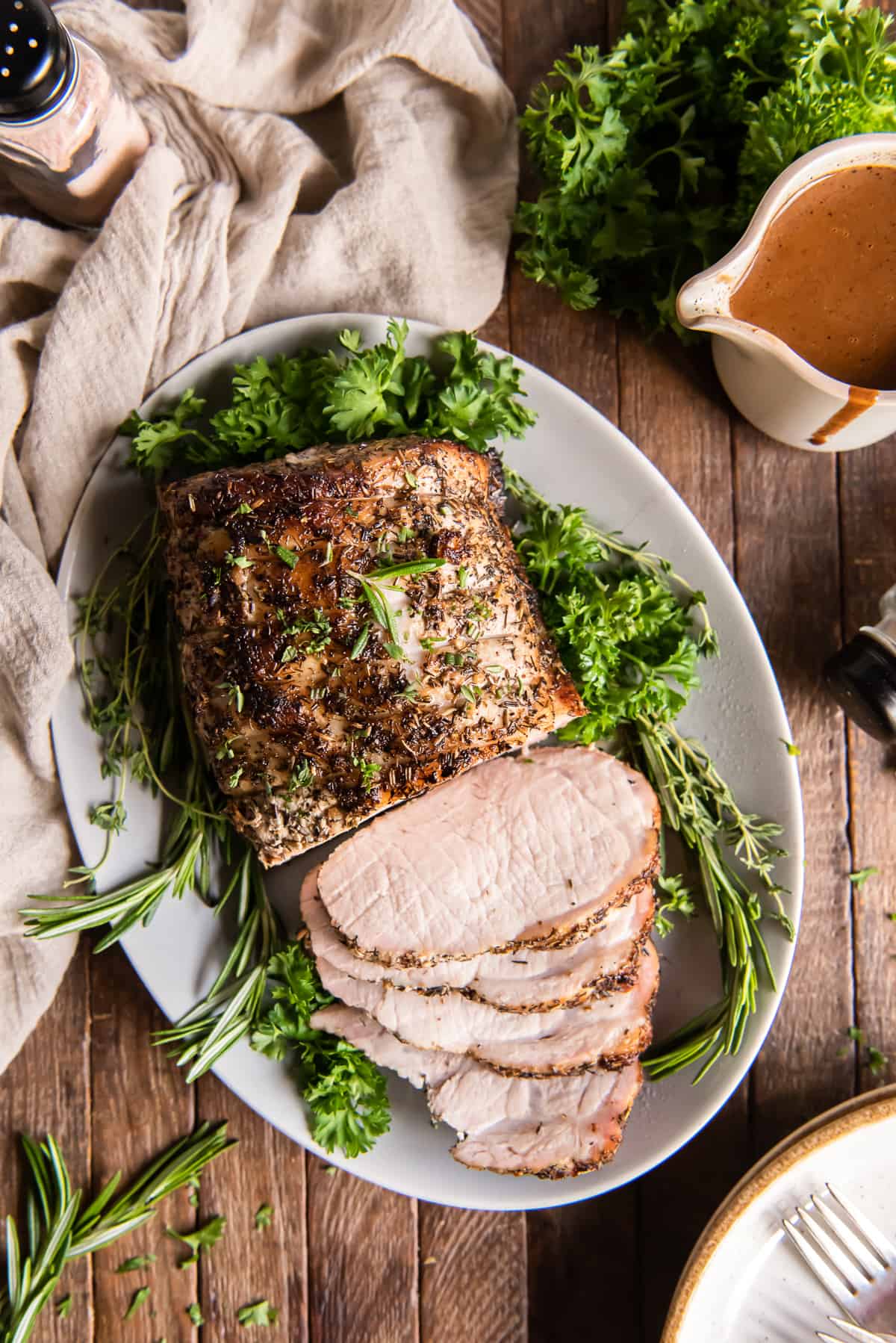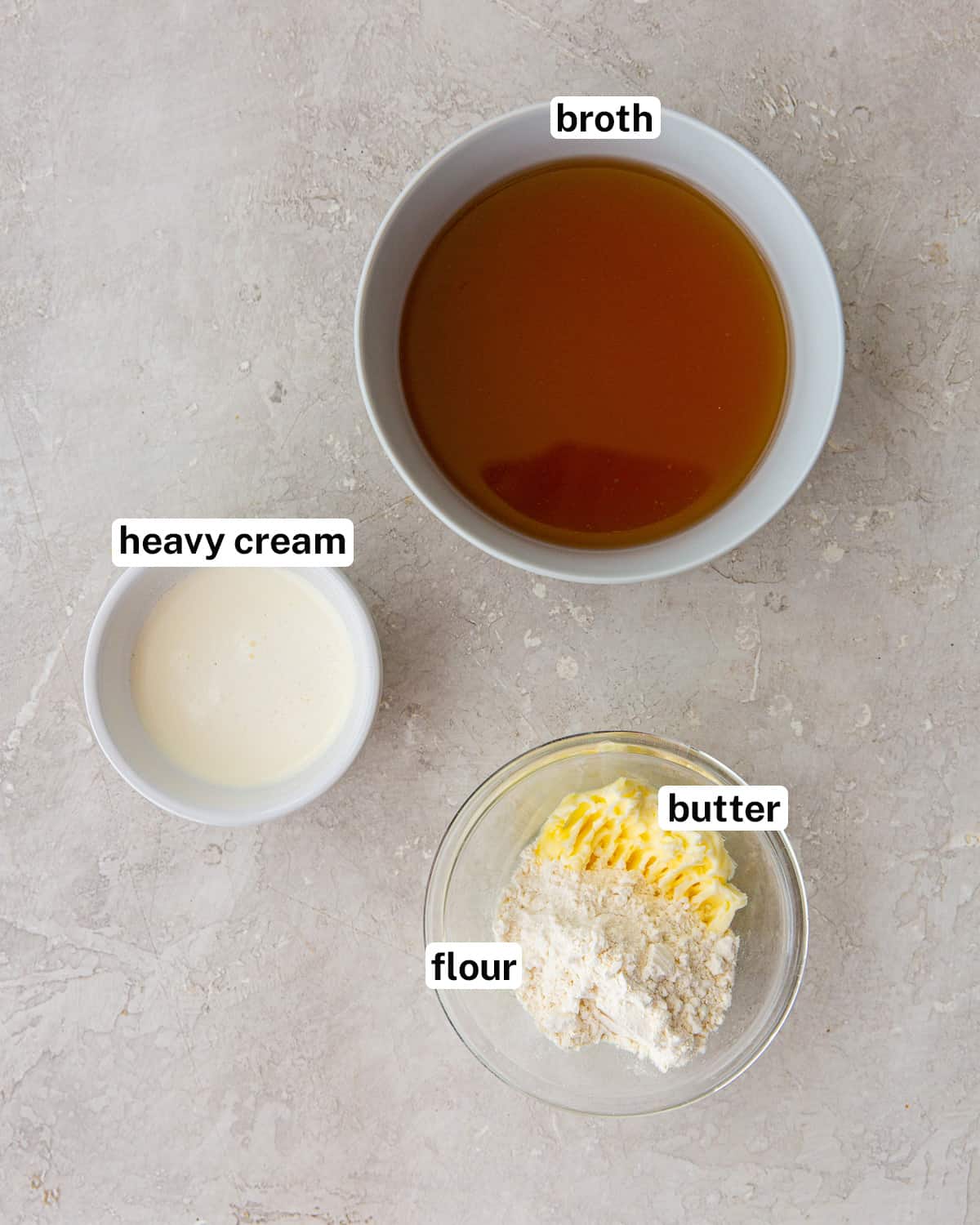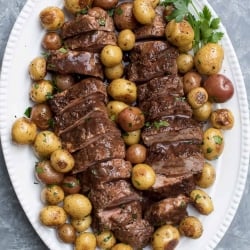Pork loin is coated in a garlic-herb paste, roasted to tender perfection, and served with the most luscious gravy. This Pork Loin Roast with Gravy is a special meal that’s worthy of a holiday menu.

I’m very excited about this recipe, friends. Not only is it utterly delicious, it’s a holiday-worthy recipe that is a more economical choice than beef, ham or turkey. But, money aside, it is unbelievably good. Like, call your best friend and give them this recipe and they’ll love ya forever! That kind of good.
Table of contents
Recipe Highlights
- Pork loin can be far less expensive than most cuts you would choose for a special occasion menu.
- Some of the prep can be done a day in advance.
- The easy, foolproof method results in a tender, flavorful pork roast.
- The luscious gravy is made in minutes and it is out of this world delicious!

If you’ve never cooked a pork roast, I’m here to hold your hand and walk you through the process. It’s a very lean cut with some special needs. But, I’m betting you’ll discover a new favorite special occasion meal with this recipe.
Ingredient Notes

For the Pork Loin Roast
- Boneless pork loin roast: You’ll need a 3 ½ to 4 pound boneless pork loin roast, not to be confused with a pork tenderloin. See more details on the difference below.
- Extra virgin olive oil
- Minced garlic
- Herbs: Rosemary and thyme. Dried herbs work great for this but if use fresh herbs, I recommend doubling the amount.
- Kosher salt: Coarse kosher salt is the best choice for this recipe. It does a better job of tenderizing the surface of the pork and creating a nice garlic and herb crust than fine ground salt.
- Freshly ground black pepper
- White wine: You want a crisp, dry white wine. My favorites are sauvignon blanc, pinot gris or pinot grigio. The bonus is once the bottle is open, you’ve got the perfect wine to serve with dinner.

For the Pork Loin Roast Gravy
- Softened butter: I always seem to forget to allow my butter to soften before cooking any recipe. If you’re like me, just microwave it on the “defrost” setting, or 30% power, in 5 second increments until you can press your finger into the side and it leaves an impression.
- All-purpose flour
- Low sodium broth: Beef broth will result in a richer, beefier gravy and chicken broth will yield a gravy slightly lighter in color. It’s wonderful with either.
- Heavy cream : Just a little cream adds the most luscious layer of richness to the gravy.

Pork Loin vs. Pork Tenderloin
A pork loin is larger and wider in shape than a pork tenderloin and will usually weigh between 2 ½ to 4 pounds. You’ll see them sold as a pork top loin, boneless pork loin, or pork center loin roast. Pork tenderloin, on the other hand, is a long, skinny cut that weighs about 1 pound. Many times you’ll find pork tenderloin sold in a package of two.
You don’t want to confuse these cuts because the cooking method for a pork loin is quite different from a pork tenderloin. A boneless pork loin roast does best with a quick sear to form the outer crust and is then finished at a lower temperature in the oven. Pork tenderloin is usually cooked quickly and at a higher temperature.

How to Make Pork Loin Roast with Gravy
Marinate the Pork Loin

- Add the olive oil, garlic, rosemary, thyme, salt and pepper to a small bowl.
- Combine it well.
- Place the pork loin on a sheet of aluminum foil that is large enough to enclose it. Pierce the pork with a sharp knife in 5 or 6 places. Smear the garlic-herb mixture over all sides of the roast.
- Enclose it in the foil and transfer it to the refrigerator to marinate for 2 to 24 hours. When you’re ready to cook the pork, allow it to rest on the counter, wrapped in foil, for 45 minutes to 1 hour to take the chill off before roasting.
I’ve made this recipe multiple times, both with and without the marinating time. I recommend allowing the pork loin to marinate for at least 2 hours or overnight for the best flavor and tenderness and to get some of the work done in advance. However, if you are short on time, the roast can be seared and roasted immediately after applying the garlic-herb paste.
Sear and Roast the Pork Loin

- Sear the roast in olive oil in a braiser or cast iron skillet over high heat. Remove it from the heat.
- Pour the wine into the skillet around the roast and cover it with the lid (if your skillet doesn’t have a lid that will fit, use aluminum foil). Roast in the oven at 375 degrees F for 45 minutes, then remove the cover and roast for another 20 to 30 minutes or until the internal temperature of the pork is at least 145 degrees F and no more than 155 degrees F.
Remove the skillet from the oven and transfer the pork to a cutting board and tent it with a sheet of foil. While the pork is resting, make the gravy.
Make the Gravy

Before starting, combine the softened butter and flour in a small bowl until it forms a smooth paste.
- Place the skillet with the pan drippings and accumulated juices over medium heat and add the broth. Whisk, scraping up any browned bits from the bottom.
- Add the butter and flour mixture. Whisk vigorously until the butter mixture is completely melted into the sauce.
- Bring the mixture to a low boil, then reduce heat to low and add the heavy cream.
- Simmer for 3 to 4 minutes, or until thickened, whisking occasionally. Taste and season to taste with salt and freshly ground pepper, only if needed (there is so much flavor in this gravy you might not need to add any additional seasoning).

FAQ and Valerie’s Tips
Absolutely, yes! Searing the seasoned pork loin creates a crisp outer crust. This step allows you to cook the pork in the oven at a lower temperature for a juicy interior.
A small amount of wine is added to the skillet just before roasting which is plenty to help the roast along. The pork loin lets off it’s own cooking juices during the roasting process that when combined with the wine, makes a super flavorful gravy. No additional liquids are needed.
Covering the roast for the first portion of the cooking time will help it retain moisture and prevent the pan juices from completely cooking off. The cover is removed towards the end of the cooking time to help the seared crust to crisp and brown a bit more.
While the minimum safe internal temperature for pork is 145 degrees F, I’ve found it best to cook pork loin roast to an internal temperature of 150 degrees F. to no more than 155 degrees F. If you pull the roast out of the oven when it’s in this range, it should be perfectly cooked with just a tiny hint of pink in the center of the thickest portion. The total roasting time can range from 20 to 25 minutes per pound. Pork loin is a lean cut that can dry out if overcooked so be vigilant and check the temperature with an instant read meat thermometer. Allow the pork to rest for 15 minutes before slicing and serving.

Storage Tips
Transfer leftover cooked pork loin to an airtight container within 2 hours and refrigerate for up to 3 to 4 days. Refrigerate leftover gravy in a separate container. Gravy will thicken when refrigerated so when reheating it, just thin to the desired consistency with a little water or additional broth.

Serving Suggestions
- Mashed Potatoes – That gravy needs a bed of creamy Sour Cream Mashed Potatoes or Buttermilk Mashed Potatoes.
- Vegetable Side Dish – Roasted Asparagus with Balsamic and Goat Cheese, Pesto Green Beans, or Broccoli Pearl Onion Casserole would all be perfect. But, any simply prepared vegetable would round out this meal.

More Special Main Dish Recipes You’ll Love
- Tender Eye of Round Roast Beef with Gravy
- Slow Cooker Ham with Peach Thyme Glaze
- Roasted Turkey Breast with Gravy
- Roasted Beef Tenderloin with Port Wine Gravy
- Maple Glazed Spiral Ham

Pork Loin Roast with Gravy
Ingredients
For the Pork Loin
- 3 ½ to 4 pound boneless pork loin roast, not tenderloin
- ¼ cup olive oil
- 1 tablespoon minced garlic
- 1 tablespoon dried rosemary, if using fresh, double the amount
- 1 tablespoon dried thyme, if using fresh, double the amount
- 1 teaspoon kosher salt
- 1 teaspoon freshly ground black pepper
- ½ cup dry white wine, like sauvignon blanc or pinot gris/pinot grigio
For the Gravy
- 2 tablespoons softened butter
- 3 tablespoons all-purpose flour
- 1 ½ cups low-sodium chicken or beef broth
- ¼ cup heavy cream
- salt and freshly ground black pepper, to taste
Instructions
Pork Loin Roast
- Remove the pork from its packaging and pat it dry with paper towels. Place it fat cap side up on a sheet of aluminum foil that is large enough to enclose it.
- Combine the olive oil, garlic, rosemary, thyme, salt and pepper. Pierce the pork with a sharp knife in 5 or 6 places. Smear the garlic-herb mixture over all sides of the roast. Enclose it completely in the foil and transfer it to the refrigerator to marinate for 2 to 24 hours. If preferred, you can cook the pork immediately after applying the garlic/herb paste to save some time (see Notes below).
- Remove the roast from the refrigerator and allow it to rest on the counter, wrapped in foil, for 45 minutes to 1 hour before roasting to take the chill off.
- Preheat oven to 375 degrees F.
- Drizzle 1 tablespoon of olive oil into a large, oven-safe skillet or braising pan and place over HIGH heat. When the oil is hot and shimmering, add the pork loin and sear until nicely browned on all sides. Turn it fat side up and remove it from the heat.
- Pour the wine into the skillet around the roast and cover it with the lid (if your skillet doesn’t have a lid that will fit, use aluminum foil). Transfer it to the oven and roast for 45 minutes, then remove the cover and roast for another 20 to 30 minutes or until the internal temperature of the pork is at least 145 degrees F and no more than 155 degrees F. Total roasting time should be about 20 to 25 minutes per pound.
- Remove the skillet from the oven and transfer the pork to a cutting board and tent it with a sheet of foil. Let it rest for 15 minutes before slicing. While the pork is resting, make the gravy.
Make the Gravy
- Add the softened butter and flour to a small bowl and work it together with a fork until it is well combined into a smooth paste. Set aside
- Place the skillet with the pork drippings and accumulated juices over MEDIUM heat and add the broth. Whisk, scraping up any browned bits from the bottom. Add the butter and flour mixture. Whisk vigorously until the butter mixture is completely melted into the sauce. Bring the mixture to a low boil, then reduce the heat to LOW and add the heavy cream. Simmer for 3 to 4 minutes, or until thickened, whisking occasionally.
- Taste and season to taste with salt and pepper, only if needed (there is so much flavor in this gravy you might not need to add any additional seasoning).
- Transfer to a gravy boat and serve with the pork loin.
Notes
Nutrition
Nutrition information is automatically calculated using generic ingredients, and is an estimate not a guarantee. For more accurate results, please refer to the labels on your ingredients at home.























This might be the best gravy I’ve had!
(We substituted sage for rosemary)
Can you add carrots and baby potatoes to this?
I made this for the first time last night. Loved it. Easy. The only consideration is having to remember to marinate it the day before. I really loved the gravy recipe. This is how I’ll be making gravy from now on. The roux paste made with soft butter and flour worked brilliantly and the gravy was delicious. My only issue was time/temp. At 45 minutes my roast was already at 165. So it was overdone. But we will be making this again. Next time I’ll check temperature earlier, and switch my broth from chicken to beef broth.
Very tasty…and the gravy is to die for!
I want to know how long would you cook it if you accidentally got the pork tenderloin?
Hi Mary. I’d recommend following a different recipe for a pork tenderloin. That cut cooks quickly and is exceptionally lean so you won’t get enough drippings to make the gravy. You might want to check out my Balsamic Glazed Pork Tenderloin, Southwestern Pork Tenderloin or Grilled Pork Tenderloin recipes.
Hi Valerie! I am very interested in making your pork roast and gravy this weekend for company. Would I be able to sub something non dairy for the cream in the gravy (for one of my guests)? Thanks for any tips!
Hi Amy. I’m so sorry I missed this until now – such a busy time of year! I hope that if you tried it, it worked out well for you. I’ve never subbed anything for the cream but I’m betting cashew milk would be a good alternative. It’s neutral in flavor and works well in gravies and sauces.